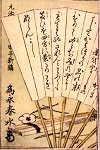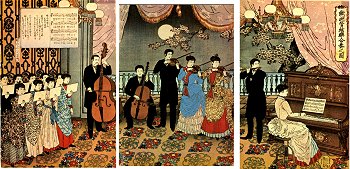
|
|
|
|
|
|
|
|
The New Face of Tokyo The face of urban Japan changed rapidly at the turn of the century. Most new construction and modernization was confined to the cities, where western and traditional architecture were combined to produce unique landmarks. Most interesting was the Ryounkaku (rising over the clouds),Tokyo's first skyscraper. The slim round edifice did indeed seem to reach to the heavens. There were twelve stories, which in- eluded three observation towers above the eighth floor and a cupola on top rising 225 feet above the ground. The first elevator to be seen in Japan was installed and operated up to the eighth floor. Junikai (twelve stories), as it was affectionately called, immediately became the most popular amusement center in Japan. It was dedicated, from basement to top, to pleasure. There were theaters, bars and restaurants on every floor. So popular was the building that thousands of wood-block prints were made for a game called sugoroku, a popular pastime played by both adults and children. The player progressed upward or downward from one landing to another depending upon the throw of a die. The area in which Junikai was located had long been one of Tokyo's amusement sections but with the construction of this building the district, called Asakusa, became the most important entertainment region of the city. Other areas of Tokyo were modernized with ugly square brick shops replacing the earlier wood and shoji structures. Typical of this change was that on the Ginza, which became the main shopping center. Modern western-style buildings began to replace earlier structures throughout the central business district called Marunouchi, which developed almost in the shadow of the Imperial Palace. But a strong and successful effort was made to retain as much of the natural beauty as possible, and it was reflected in forested groves, parks and temple grounds. Architectural borrowing from the West stopped in the urban areas. In towns and villages and throughout the countryside, Japanese architecture continued to develop along traditional lines.
|

